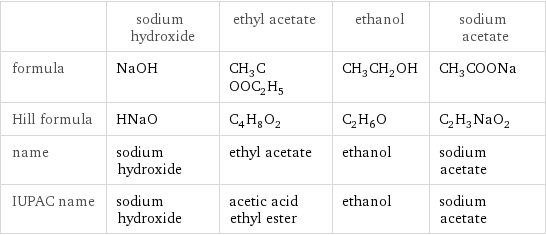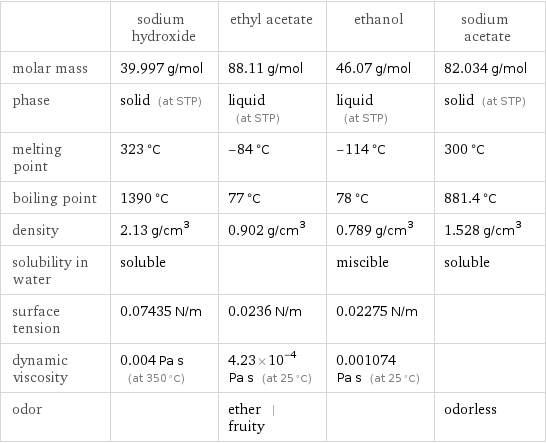Input interpretation

NaOH sodium hydroxide + CH_3COOC_2H_5 ethyl acetate ⟶ CH_3CH_2OH ethanol + CH_3COONa sodium acetate
Balanced equation

Balance the chemical equation algebraically: NaOH + CH_3COOC_2H_5 ⟶ CH_3CH_2OH + CH_3COONa Add stoichiometric coefficients, c_i, to the reactants and products: c_1 NaOH + c_2 CH_3COOC_2H_5 ⟶ c_3 CH_3CH_2OH + c_4 CH_3COONa Set the number of atoms in the reactants equal to the number of atoms in the products for H, Na, O and C: H: | c_1 + 8 c_2 = 6 c_3 + 3 c_4 Na: | c_1 = c_4 O: | c_1 + 2 c_2 = c_3 + 2 c_4 C: | 4 c_2 = 2 c_3 + 2 c_4 Since the coefficients are relative quantities and underdetermined, choose a coefficient to set arbitrarily. To keep the coefficients small, the arbitrary value is ordinarily one. For instance, set c_1 = 1 and solve the system of equations for the remaining coefficients: c_1 = 1 c_2 = 1 c_3 = 1 c_4 = 1 Substitute the coefficients into the chemical reaction to obtain the balanced equation: Answer: | | NaOH + CH_3COOC_2H_5 ⟶ CH_3CH_2OH + CH_3COONa
Structures

+ ⟶ +
Names

sodium hydroxide + ethyl acetate ⟶ ethanol + sodium acetate
Equilibrium constant
![Construct the equilibrium constant, K, expression for: NaOH + CH_3COOC_2H_5 ⟶ CH_3CH_2OH + CH_3COONa Plan: • Balance the chemical equation. • Determine the stoichiometric numbers. • Assemble the activity expression for each chemical species. • Use the activity expressions to build the equilibrium constant expression. Write the balanced chemical equation: NaOH + CH_3COOC_2H_5 ⟶ CH_3CH_2OH + CH_3COONa Assign stoichiometric numbers, ν_i, using the stoichiometric coefficients, c_i, from the balanced chemical equation in the following manner: ν_i = -c_i for reactants and ν_i = c_i for products: chemical species | c_i | ν_i NaOH | 1 | -1 CH_3COOC_2H_5 | 1 | -1 CH_3CH_2OH | 1 | 1 CH_3COONa | 1 | 1 Assemble the activity expressions accounting for the state of matter and ν_i: chemical species | c_i | ν_i | activity expression NaOH | 1 | -1 | ([NaOH])^(-1) CH_3COOC_2H_5 | 1 | -1 | ([CH3COOC2H5])^(-1) CH_3CH_2OH | 1 | 1 | [CH3CH2OH] CH_3COONa | 1 | 1 | [CH3COONa] The equilibrium constant symbol in the concentration basis is: K_c Mulitply the activity expressions to arrive at the K_c expression: Answer: | | K_c = ([NaOH])^(-1) ([CH3COOC2H5])^(-1) [CH3CH2OH] [CH3COONa] = ([CH3CH2OH] [CH3COONa])/([NaOH] [CH3COOC2H5])](../image_source/77d9abc943cde1025b784e9ed3ce97fa.png)
Construct the equilibrium constant, K, expression for: NaOH + CH_3COOC_2H_5 ⟶ CH_3CH_2OH + CH_3COONa Plan: • Balance the chemical equation. • Determine the stoichiometric numbers. • Assemble the activity expression for each chemical species. • Use the activity expressions to build the equilibrium constant expression. Write the balanced chemical equation: NaOH + CH_3COOC_2H_5 ⟶ CH_3CH_2OH + CH_3COONa Assign stoichiometric numbers, ν_i, using the stoichiometric coefficients, c_i, from the balanced chemical equation in the following manner: ν_i = -c_i for reactants and ν_i = c_i for products: chemical species | c_i | ν_i NaOH | 1 | -1 CH_3COOC_2H_5 | 1 | -1 CH_3CH_2OH | 1 | 1 CH_3COONa | 1 | 1 Assemble the activity expressions accounting for the state of matter and ν_i: chemical species | c_i | ν_i | activity expression NaOH | 1 | -1 | ([NaOH])^(-1) CH_3COOC_2H_5 | 1 | -1 | ([CH3COOC2H5])^(-1) CH_3CH_2OH | 1 | 1 | [CH3CH2OH] CH_3COONa | 1 | 1 | [CH3COONa] The equilibrium constant symbol in the concentration basis is: K_c Mulitply the activity expressions to arrive at the K_c expression: Answer: | | K_c = ([NaOH])^(-1) ([CH3COOC2H5])^(-1) [CH3CH2OH] [CH3COONa] = ([CH3CH2OH] [CH3COONa])/([NaOH] [CH3COOC2H5])
Rate of reaction
![Construct the rate of reaction expression for: NaOH + CH_3COOC_2H_5 ⟶ CH_3CH_2OH + CH_3COONa Plan: • Balance the chemical equation. • Determine the stoichiometric numbers. • Assemble the rate term for each chemical species. • Write the rate of reaction expression. Write the balanced chemical equation: NaOH + CH_3COOC_2H_5 ⟶ CH_3CH_2OH + CH_3COONa Assign stoichiometric numbers, ν_i, using the stoichiometric coefficients, c_i, from the balanced chemical equation in the following manner: ν_i = -c_i for reactants and ν_i = c_i for products: chemical species | c_i | ν_i NaOH | 1 | -1 CH_3COOC_2H_5 | 1 | -1 CH_3CH_2OH | 1 | 1 CH_3COONa | 1 | 1 The rate term for each chemical species, B_i, is 1/ν_i(Δ[B_i])/(Δt) where [B_i] is the amount concentration and t is time: chemical species | c_i | ν_i | rate term NaOH | 1 | -1 | -(Δ[NaOH])/(Δt) CH_3COOC_2H_5 | 1 | -1 | -(Δ[CH3COOC2H5])/(Δt) CH_3CH_2OH | 1 | 1 | (Δ[CH3CH2OH])/(Δt) CH_3COONa | 1 | 1 | (Δ[CH3COONa])/(Δt) (for infinitesimal rate of change, replace Δ with d) Set the rate terms equal to each other to arrive at the rate expression: Answer: | | rate = -(Δ[NaOH])/(Δt) = -(Δ[CH3COOC2H5])/(Δt) = (Δ[CH3CH2OH])/(Δt) = (Δ[CH3COONa])/(Δt) (assuming constant volume and no accumulation of intermediates or side products)](../image_source/e27b86443daddfb7c15690f7c1c95af6.png)
Construct the rate of reaction expression for: NaOH + CH_3COOC_2H_5 ⟶ CH_3CH_2OH + CH_3COONa Plan: • Balance the chemical equation. • Determine the stoichiometric numbers. • Assemble the rate term for each chemical species. • Write the rate of reaction expression. Write the balanced chemical equation: NaOH + CH_3COOC_2H_5 ⟶ CH_3CH_2OH + CH_3COONa Assign stoichiometric numbers, ν_i, using the stoichiometric coefficients, c_i, from the balanced chemical equation in the following manner: ν_i = -c_i for reactants and ν_i = c_i for products: chemical species | c_i | ν_i NaOH | 1 | -1 CH_3COOC_2H_5 | 1 | -1 CH_3CH_2OH | 1 | 1 CH_3COONa | 1 | 1 The rate term for each chemical species, B_i, is 1/ν_i(Δ[B_i])/(Δt) where [B_i] is the amount concentration and t is time: chemical species | c_i | ν_i | rate term NaOH | 1 | -1 | -(Δ[NaOH])/(Δt) CH_3COOC_2H_5 | 1 | -1 | -(Δ[CH3COOC2H5])/(Δt) CH_3CH_2OH | 1 | 1 | (Δ[CH3CH2OH])/(Δt) CH_3COONa | 1 | 1 | (Δ[CH3COONa])/(Δt) (for infinitesimal rate of change, replace Δ with d) Set the rate terms equal to each other to arrive at the rate expression: Answer: | | rate = -(Δ[NaOH])/(Δt) = -(Δ[CH3COOC2H5])/(Δt) = (Δ[CH3CH2OH])/(Δt) = (Δ[CH3COONa])/(Δt) (assuming constant volume and no accumulation of intermediates or side products)
Chemical names and formulas

| sodium hydroxide | ethyl acetate | ethanol | sodium acetate formula | NaOH | CH_3COOC_2H_5 | CH_3CH_2OH | CH_3COONa Hill formula | HNaO | C_4H_8O_2 | C_2H_6O | C_2H_3NaO_2 name | sodium hydroxide | ethyl acetate | ethanol | sodium acetate IUPAC name | sodium hydroxide | acetic acid ethyl ester | ethanol | sodium acetate
Substance properties

| sodium hydroxide | ethyl acetate | ethanol | sodium acetate molar mass | 39.997 g/mol | 88.11 g/mol | 46.07 g/mol | 82.034 g/mol phase | solid (at STP) | liquid (at STP) | liquid (at STP) | solid (at STP) melting point | 323 °C | -84 °C | -114 °C | 300 °C boiling point | 1390 °C | 77 °C | 78 °C | 881.4 °C density | 2.13 g/cm^3 | 0.902 g/cm^3 | 0.789 g/cm^3 | 1.528 g/cm^3 solubility in water | soluble | | miscible | soluble surface tension | 0.07435 N/m | 0.0236 N/m | 0.02275 N/m | dynamic viscosity | 0.004 Pa s (at 350 °C) | 4.23×10^-4 Pa s (at 25 °C) | 0.001074 Pa s (at 25 °C) | odor | | ether | fruity | | odorless
Units
